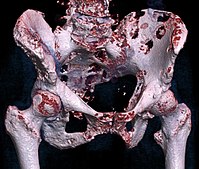
Photo from wikipedia
As head and neck squamous cell carcinoma (HNSCC) patients with distant metastases (DM) were generally treated only palliatively, the value of screening for DM was usually limited to attempts to… Click to show full abstract
As head and neck squamous cell carcinoma (HNSCC) patients with distant metastases (DM) were generally treated only palliatively, the value of screening for DM was usually limited to attempts to avoid extensive locoregional treatment when DM were present pretreatment. Recently, the concept of treating oligometastases, e.g., by metastatectomy or stereotactic body radiotherapy, has been reintroduced for HNSCC and may cause a change in the treatment paradigm. Although whole body 18F-fluoro-2-deoxy-d-glucose positron emission tomography (FDG-PET) combined with computed tomography (CT; WB-FDG-PET/CT) is still the mainstay diagnostic technique, there is a growing body of evidence supporting implementation of whole body magnetic resonance imaging (WB-MRI) as an important diagnostic technique for screening for DM. Also, FDG-PET/MRI may become a valuable technique for the detection of DM in HNSCC patients. Because the yield of examinations for detection of DM is too low to warrant routine screening of all HNSCC patients, only patients with high risk factors should be selected for intense screening for DM. Clinical and histopathological risk factors are mainly related to the extent of lymph node metastases. Risk for development of DM may also be assessed by molecular characterization of the primary tumor using genomic and proteomic technologies and radiomics. More research is needed to develop a new protocol for screening for DM after introduction of the concept of treating oligometastases in HNSCC.
Journal Title: Advances in Therapy
Year Published: 2018
Link to full text (if available)
Share on Social Media: Sign Up to like & get
recommendations!